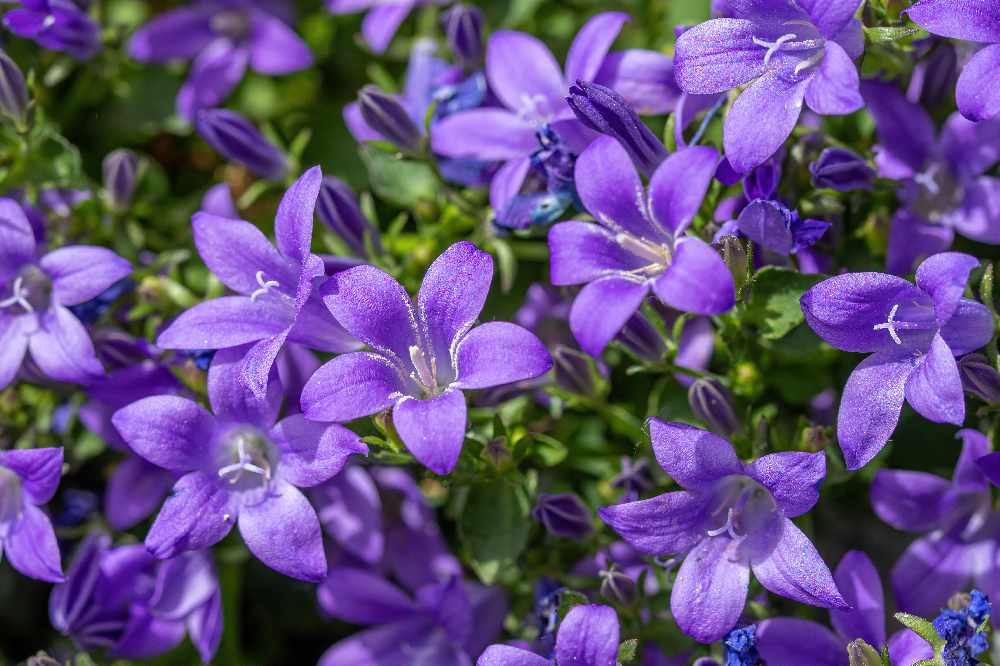
Plant Heritage, a leading horticultural conservation charity, is calling for Islanders to help save ten different plant groups at risk of being lost from our gardens.
Anyone with a passion for plants, or whose interest in gardening or caring for houseplants was sparked during 2020’s lockdowns, is being asked to consider looking after a specific plant group as part of Plant Heritage’s annual ‘Missing Genera’ campaign.
Each year the Missing Genera showcases different plant groups that aren’t cared for as part of a ‘National Plant Collection’.
If plants aren’t being actively conserved in these collections, they are at risk of disappearing from cultivation.
Since the campaign began in 2016, the Missing Genera has resulted in eight new National Plant Collections conserving over 650 species and cultivars, including Alcea (Hollyhocks) and Aeonium, and there are many more in the process of building up their collection.
Two plant groups on the 2021 Missing Genera: Campanula 'Samantha' (L) and Zantedeschia ‘Zazu’
This year, the ten plant varieties in need of a home are:
- Campanula: Also known as bellflowers, these distinctive open, bell-shaped flowers come in shades blue, pink, purple and white, and range from creeping alpine plants to tall border favourites. There are about 80 species and a staggering 232 cultivars available, but it would be possible to look after a subset to avoid collecting them all!
- Erigeron: Related to daisies, Erigeron can be annuals, biennials or perennial. They thrive in sunny spots with some happily growing through the cracks in paving. There are 30 cultivars currently available in the UK, with many more to be found worldwide.
- Lysimachia: From creeping, ground cover plants to stately perennials, this genus can survive in a variety of settings. The UK native species have yellow flowers, but the garden types include whites and deep maroons.
- Papaver (Oriental Group): These pretty perennial poppies are a stalwart of early summer. Since the 19th century oriental poppies have been bred to produce a range of coloured flowers, from pastel shades to deep plums, in addition to their original red.
- Phormium: Also called New Zealand flax, this vigorous, easy to grow plant looks good all year round. Good for windy or coastal sites, the long, strap-like leaves vary from deep purples to reds and yellows, and can also be striped. There are about 60 cultivars available.
- Phygelius: These are low growing evergreen shrubs but are often treated as perennials. The tubular flowers are held on long stems and come in stunning tones of pink, red and occasionally yellow, and will last from mid-summer into the autumn.
- Pittosporum: The glossy, evergreen leaves are the standout feature of these shrubs or small trees, which can be used for hedging, ground cover or as specimen plants. The small flowers can be scented and are produced in late spring to early summer.
- Sansevieria: These make popular houseplants due to their tolerance for low light. Also known as ‘mother-in-law’s tongues’, the upright, leathery leaves come in many patterns of variegation.
- Silene: Some Silene are familiar wildflowers, also known as ‘campions’ or ‘catchflys’. There are many other species to be found in the UK, from alpines to border perennials. The colour palette of Silene ranges from pinks, lilacs, whites and reds, and they flower from late spring through early summer.
- Zantedeschia: Commonly called arum lilies, these hardy, outdoor plant tends to have white flowers and thrive in damp places. There are also more tender forms that come in a range of colours. There are about 70 cultivars available of these dramatic plants in the UK.
Vicki Cooke, Conservation Manager at Plant Heritage said:
“Starting a National Plant Collection doesn’t have to be daunting – in fact, we have several that are cared for in homes, conservatories and gardens! Anyone can help, and by caring for a plant group means that future generations can enjoy them as much as we do now.
"What matters is that the interest and love for saving a plant is there, so we really hope the ten plants on this year’s Missing Genera list find their future Collection Holder soon.”
To find out more about the Missing Genera, visit: https://www.plantheritage.org.uk/national-plant-collections/missing-genera/ and to find out how to start a National Plant Collection of one of the above plant groups, visit: https://www.plantheritage.org.uk/national-plant-collections/start-a-national-plant-collection
To find out more about Plant Heritage, its National Plant Collections or for information about how to become a Collection Holder, Plant Guardian, National Collection Sponsor or member, visit www.plantheritage.org.uk .


 "There's Likely To Be In Excess Of 200 Redundancies": Island Trade Unionists On School Plans
"There's Likely To Be In Excess Of 200 Redundancies": Island Trade Unionists On School Plans
 High Sheriff Presents Inaugural Maritime Volunteers Award To Cowes RNLI Station
High Sheriff Presents Inaugural Maritime Volunteers Award To Cowes RNLI Station
 Education Cabinet Member Faces Renewed Round Of Questions From Concerned Residents
Education Cabinet Member Faces Renewed Round Of Questions From Concerned Residents
 Man Jailed After burglaries Armed With Baseball Bat And Firearm
Man Jailed After burglaries Armed With Baseball Bat And Firearm
 Retailers Say Hampshire & Isle Of Wight Constabulary Is Best At Responding To Retail Crime
Retailers Say Hampshire & Isle Of Wight Constabulary Is Best At Responding To Retail Crime
 Full Council Opposes School Closure Plans In Blow To Cabinet
Full Council Opposes School Closure Plans In Blow To Cabinet
 Eight Electric Vehicle Charging Bays Could Be Installed In Isle Of Wight Town Centre
Eight Electric Vehicle Charging Bays Could Be Installed In Isle Of Wight Town Centre
 New Drop-In Sessions Announced For Isle Of Wight Dementia Strategy Review
New Drop-In Sessions Announced For Isle Of Wight Dementia Strategy Review
 Plans To Enhance Luxury Freshwater Seafront Hotel Approved
Plans To Enhance Luxury Freshwater Seafront Hotel Approved
 Thousands Of Pounds Of Investment Needed If Housing Development Goes
Thousands Of Pounds Of Investment Needed If Housing Development Goes
 Isle Of Wight College Firearm Report Sees 17 Year-Old Arrested In Cowes
Isle Of Wight College Firearm Report Sees 17 Year-Old Arrested In Cowes
 Major Island Policy Forum To Consider Plans Aiming To Make Suicide Prevention 'Everybody's Business'
Major Island Policy Forum To Consider Plans Aiming To Make Suicide Prevention 'Everybody's Business'
 Latest Scam Warnings Issued For Isle Of Wight
Latest Scam Warnings Issued For Isle Of Wight
 First Acts Announced For Cowes Fringe 2025
First Acts Announced For Cowes Fringe 2025
 Six Island Charities Supported By WightAID In Final Giving Round Of 2024
Six Island Charities Supported By WightAID In Final Giving Round Of 2024
 Two New Sites For Isle Of Wight's Gift To Nature
Two New Sites For Isle Of Wight's Gift To Nature
 Councillors Lodge Motions Ahead Of Landmark School Closures Debate
Councillors Lodge Motions Ahead Of Landmark School Closures Debate
 Ryde Town Centre Victorian Warehouse Could Get Three New Flats
Ryde Town Centre Victorian Warehouse Could Get Three New Flats
 Controversial Bid To Build Renewable Energy Park Near Island Village Re-Emerges
Controversial Bid To Build Renewable Energy Park Near Island Village Re-Emerges
 East Wight Road Improvement Work To Take Place In February
East Wight Road Improvement Work To Take Place In February


